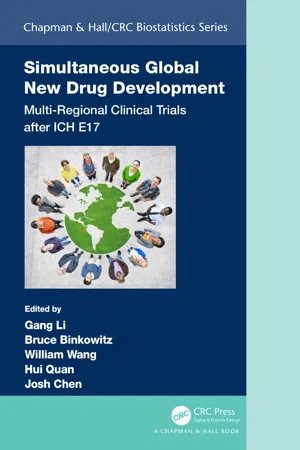
Simultaneous Global New Drug Development
Multi-Regional Clinical Trials after ICH E17
- 344 pages
- English
- ePUB (mobile friendly)
- Available on iOS & Android
Simultaneous Global New Drug Development
Multi-Regional Clinical Trials after ICH E17
About this book
Global simultaneous development is becoming more necessary as the cost of developing medical products continues to grow. The strategy of using multiregional clinical trials (MRCTs) has become the preferred method for developing new medicines. Implementing the same protocol to include subjects from many geographical regions around the world, MRCTs can speed up the patient enrolment, thus resulting in quicker drug development and obtaining faster approval of the drug globally.
After the publication of the editors' first volume on this topic, there have been new developments on MRCTs. The International Council for Harmonisation (ICH) issued ICH E17, a guideline document on MRCTs, in November 2017, laying out principles on MRCTs. Beyond E17, new methodologies have been developed as well.
Simultaneous Global New Drug Development: Multi-Regional Clinical Trials after ICH E17 collects chapters providing interpretations of principles in ICH E17 and new ideas of implementing MRCTs. Authors are from different regions, and from academia and industry. In addition, in contrast to the first book, new perspectives are brought to MRCT from regulatory agencies.
This book will be of particular interest to biostatisticians working in late stage clinical development of medical products. It will also be especially helpful for statisticians in regulatory agencies, and medical research institutes.
This book is comprehensive across the MRCT topic spectrum, including
- Issues regarding ICH E17 Implementation
- MRCT Design and Analysis Methodologies
- Perspectives from authorities in regulatory agencies, as well as statisticians practicing in the medical product industry
- Many examples of real-life applications based on actual MRCTs
Frequently asked questions
- Essential is ideal for learners and professionals who enjoy exploring a wide range of subjects. Access the Essential Library with 800,000+ trusted titles and best-sellers across business, personal growth, and the humanities. Includes unlimited reading time and Standard Read Aloud voice.
- Complete: Perfect for advanced learners and researchers needing full, unrestricted access. Unlock 1.4M+ books across hundreds of subjects, including academic and specialized titles. The Complete Plan also includes advanced features like Premium Read Aloud and Research Assistant.
Please note we cannot support devices running on iOS 13 and Android 7 or earlier. Learn more about using the app.
Information
1 General Introduction of E17
1.1 Paradigm Shift of the Drug Development Strategy


1.2 Backstory of the ICH E17 Expert Working Group
1.2.1 Why Were the ICH E17 Guidelines Established?
1.2.2 The History of the ICH E17 Guideline

1.3 Key Principles of the ICH E17 Guideline
Table of contents
- Cover
- Half Title
- Series Page
- Title Page
- Copyright
- Contents
- Preface
- Editor Biographies
- List of Contributors
- 1 General Introduction of E17
- 2 New Principles in Global Development Using ICH E 17 Guideline
- 3 Consideration of “Ethnic Factors” in Design and Conduct of Multiregional Clinical Trials (MRCT)
- 4 Pooling Strategies
- 5 Overall Sample Size and Allocation to Regions
- 6 Consistency Evaluation in MRCTs
- 7 Implementation of the ICH E17 Guideline in Japan
- 8 ICH E17 and MRCT: Implementation and Regulatory Perspective in China
- 9 Lessons Learned from Actual Multi-Regional Clinical Trials with Signals of Treatment Effect Heterogeneity
- 10 Leveraging Foreign Clinical Data Extrapolation to Accelerate Global Drug Development: A Case Study in Hematological Oncology
- 11 Analysis Models for Multi-regional Clinical Trials
- 12 Utilization of Robust Estimates of Treatment Effects via Semiparametric Models in MRCT
- 13 Hierarchical Linear Models for Multi-Regional Clinical Trials
- 14 Local Treatment Effect Estimation by Borrowing Information from Similar Regions in Multi-Regional Clinical Trials
- 15 Global Drug Development: Multi-Regional Clinical Trials (MRCTs) – China's Pursuit
- 16 Statistical Considerations in Design, Execution, and Analysis of Multiregional Clinical Trials: Consistency Evaluation and Adaptive Trials
- 17 Multiple Endpoints in Multiregional Clinical Trials
- 18 Multi-regional Clinical Trials with Heterogeneous Regional Treatment Effects
- 19 Regional Sample Size Calculation in Multi-regional Equivalence and Non-inferiority Trials
- Index